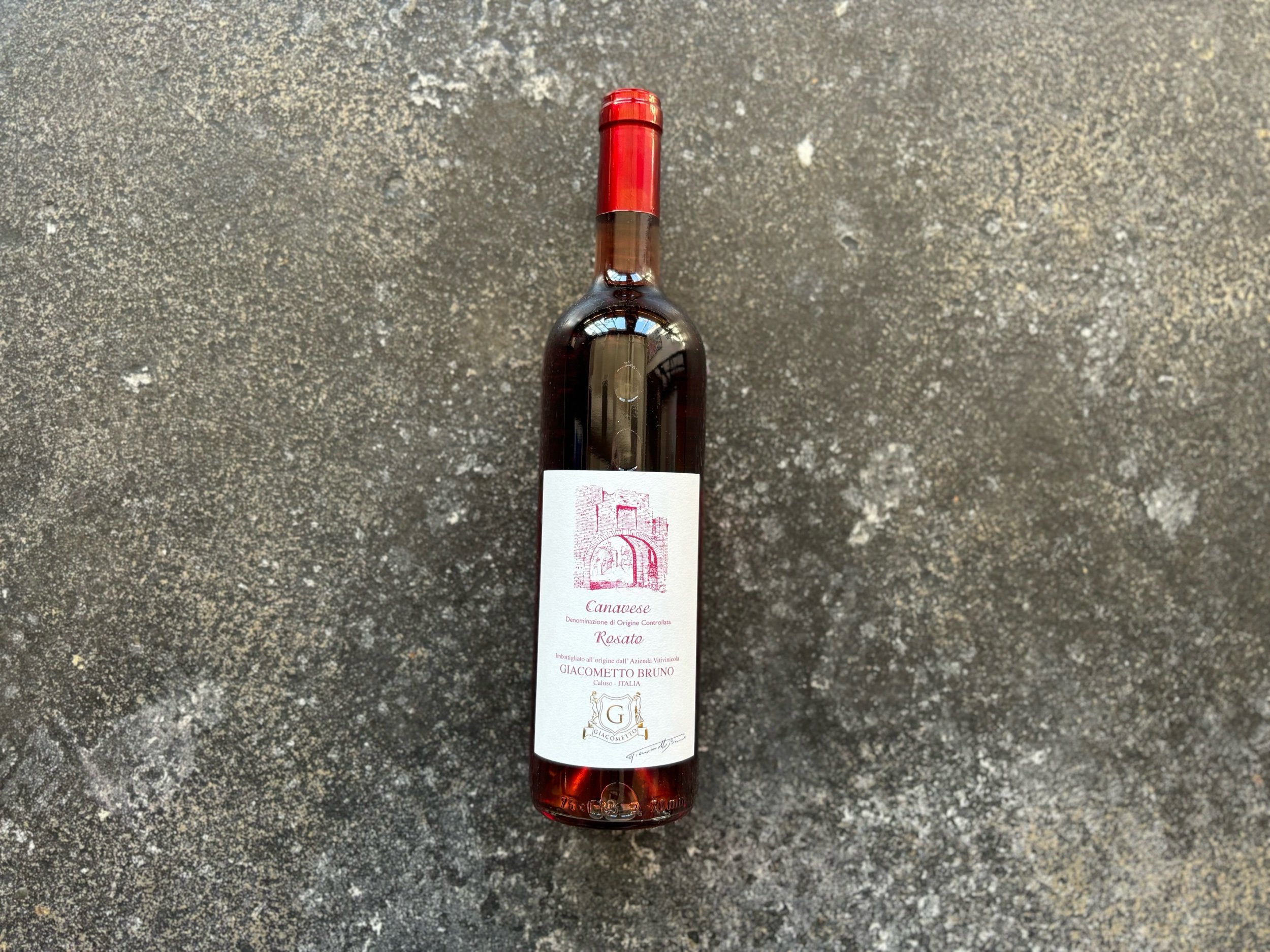Bruno Giacometto Canavese Rosato 2021
Location: Italy, Piedmont, Caluso
Winemaker: Bruno Giacometto
Grapes: Nebbiolo, Barbera, Neretto di Bairo, Freisa, Merlot
Soil: The plots where Giacometto’s red grape varieties grow feature morainic soils from the Quaternary Period. These soils are typical of a subalpine zone known as the Canavese, which is centered on the town of Caluso. The soils are sandy and stony, composed of pebbles originating from the glacier on the Mont Blanc massif. They are rich in mineral salts and yield remarkable acidity and sapidity in the wines of the zone. The Indo- European Celtic tribes were the first to cultivate this vine in the area.
Winemaking: The harvested bunches are placed in ventilated crates and stored for 4-5 days at 39°F, a process known as pre- cryomaceration. These crates enable the cold air to chill all the bunches without the occurrence of condensation. Pre-cryomaceration results in wines with a fresh fruit profile that are rounder, more balanced, and notably ageworthy. It also empowers Bruno to make minimal sulfur additions. The chilled grapes are pressed in a pneumatic tank and left in contact with the skins for 2-4 hours. Afterward, the grapes are pressed gently but continuously in order to achieve a cleaner must.
Alcoholic fermentation occurs spontaneously in temperature-controlled stainless-steel tanks at 61-63°F. The wine is subsequently racked to stainless-steel tanks, where it remains in contact with the fine lees. Tartaric stabilization is effectuated through cold precipitation, after which the wine is bottled.
The winery has been certified organic by ICEA since 2019
From the Importer Piedmont Guy: Bruno Giacometto is the force behind a dazzling array of bottlings vinified naturally from Erbaluce, a thick-skinned, high-acid white grape variety native to northern Piedmont. Bruno’s ebullience belies his age, and he claims to have never married because Erbaluce is the one true love of his life. Erbaluce di Caluso was Piedmont’s first official white-wine appellation, formalized as a DOC in 1967 and subsequently elevated to DOCG status in 2010. The DOCG encompasses only Erbaluce grown in the zone of Caluso, “where the best Erbaluce wines in Italy are made,” according to Wine Scholar Ian D’Agata. With centuries of family ties to the historic town of Caluso and a winemaking lineage dating back to the early 1960s, Bruno feels most at home in the pergola-trained Erbaluce vineyards of his zone, though he also maintains small parcels of native red grapes like Nebbiolo, Barbera, Neretto, and Freisa. The estate of Bruno Giacometto has been certified organic by ICEA since 2019.
Location: Italy, Piedmont, Caluso
Winemaker: Bruno Giacometto
Grapes: Nebbiolo, Barbera, Neretto di Bairo, Freisa, Merlot
Soil: The plots where Giacometto’s red grape varieties grow feature morainic soils from the Quaternary Period. These soils are typical of a subalpine zone known as the Canavese, which is centered on the town of Caluso. The soils are sandy and stony, composed of pebbles originating from the glacier on the Mont Blanc massif. They are rich in mineral salts and yield remarkable acidity and sapidity in the wines of the zone. The Indo- European Celtic tribes were the first to cultivate this vine in the area.
Winemaking: The harvested bunches are placed in ventilated crates and stored for 4-5 days at 39°F, a process known as pre- cryomaceration. These crates enable the cold air to chill all the bunches without the occurrence of condensation. Pre-cryomaceration results in wines with a fresh fruit profile that are rounder, more balanced, and notably ageworthy. It also empowers Bruno to make minimal sulfur additions. The chilled grapes are pressed in a pneumatic tank and left in contact with the skins for 2-4 hours. Afterward, the grapes are pressed gently but continuously in order to achieve a cleaner must.
Alcoholic fermentation occurs spontaneously in temperature-controlled stainless-steel tanks at 61-63°F. The wine is subsequently racked to stainless-steel tanks, where it remains in contact with the fine lees. Tartaric stabilization is effectuated through cold precipitation, after which the wine is bottled.
The winery has been certified organic by ICEA since 2019
From the Importer Piedmont Guy: Bruno Giacometto is the force behind a dazzling array of bottlings vinified naturally from Erbaluce, a thick-skinned, high-acid white grape variety native to northern Piedmont. Bruno’s ebullience belies his age, and he claims to have never married because Erbaluce is the one true love of his life. Erbaluce di Caluso was Piedmont’s first official white-wine appellation, formalized as a DOC in 1967 and subsequently elevated to DOCG status in 2010. The DOCG encompasses only Erbaluce grown in the zone of Caluso, “where the best Erbaluce wines in Italy are made,” according to Wine Scholar Ian D’Agata. With centuries of family ties to the historic town of Caluso and a winemaking lineage dating back to the early 1960s, Bruno feels most at home in the pergola-trained Erbaluce vineyards of his zone, though he also maintains small parcels of native red grapes like Nebbiolo, Barbera, Neretto, and Freisa. The estate of Bruno Giacometto has been certified organic by ICEA since 2019.
Location: Italy, Piedmont, Caluso
Winemaker: Bruno Giacometto
Grapes: Nebbiolo, Barbera, Neretto di Bairo, Freisa, Merlot
Soil: The plots where Giacometto’s red grape varieties grow feature morainic soils from the Quaternary Period. These soils are typical of a subalpine zone known as the Canavese, which is centered on the town of Caluso. The soils are sandy and stony, composed of pebbles originating from the glacier on the Mont Blanc massif. They are rich in mineral salts and yield remarkable acidity and sapidity in the wines of the zone. The Indo- European Celtic tribes were the first to cultivate this vine in the area.
Winemaking: The harvested bunches are placed in ventilated crates and stored for 4-5 days at 39°F, a process known as pre- cryomaceration. These crates enable the cold air to chill all the bunches without the occurrence of condensation. Pre-cryomaceration results in wines with a fresh fruit profile that are rounder, more balanced, and notably ageworthy. It also empowers Bruno to make minimal sulfur additions. The chilled grapes are pressed in a pneumatic tank and left in contact with the skins for 2-4 hours. Afterward, the grapes are pressed gently but continuously in order to achieve a cleaner must.
Alcoholic fermentation occurs spontaneously in temperature-controlled stainless-steel tanks at 61-63°F. The wine is subsequently racked to stainless-steel tanks, where it remains in contact with the fine lees. Tartaric stabilization is effectuated through cold precipitation, after which the wine is bottled.
The winery has been certified organic by ICEA since 2019
From the Importer Piedmont Guy: Bruno Giacometto is the force behind a dazzling array of bottlings vinified naturally from Erbaluce, a thick-skinned, high-acid white grape variety native to northern Piedmont. Bruno’s ebullience belies his age, and he claims to have never married because Erbaluce is the one true love of his life. Erbaluce di Caluso was Piedmont’s first official white-wine appellation, formalized as a DOC in 1967 and subsequently elevated to DOCG status in 2010. The DOCG encompasses only Erbaluce grown in the zone of Caluso, “where the best Erbaluce wines in Italy are made,” according to Wine Scholar Ian D’Agata. With centuries of family ties to the historic town of Caluso and a winemaking lineage dating back to the early 1960s, Bruno feels most at home in the pergola-trained Erbaluce vineyards of his zone, though he also maintains small parcels of native red grapes like Nebbiolo, Barbera, Neretto, and Freisa. The estate of Bruno Giacometto has been certified organic by ICEA since 2019.

